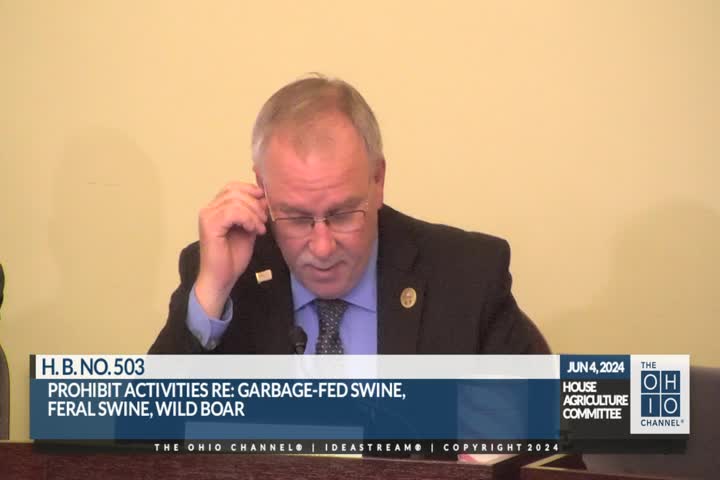Ohio takes action to combat invasive feral swine threat
June 04, 2024 | Agriculture, House of Representatives, Committees, Legislative, Ohio

This article was created by AI summarizing key points discussed. AI makes mistakes, so for full details and context, please refer to the video of the full meeting. Please report any errors so we can fix them. Report an error »

During a recent government meeting, officials discussed the growing threat posed by feral swine in Ohio and the measures being proposed to mitigate their impact on agriculture and public health. The meeting featured testimony from various stakeholders, including representatives from wildlife services and the Ohio Farm Bureau Federation.
A key focus was on the proper disposal of feral swine after they are eliminated, as these animals can carry diseases that threaten both livestock and human health. Wildlife services emphasized the importance of controlled elimination methods, which include trapping and testing for diseases such as pseudorabies and African swine fever. These measures are crucial for preventing the spread of infections that could devastate local agriculture.
Whitney Bowers, director of state policy at the Ohio Farm Bureau, provided proponent testimony on House Bill 503, which aims to limit the presence of feral swine in the state. Bowers highlighted that feral swine are an invasive species that cause significant damage to crops, pasturelands, and water sources, threatening the livelihoods of farmers and the stability of Ohio's food production. She noted that these animals are known carriers of numerous diseases, which could have severe implications for both livestock and public health.
The proposed legislation is seen as a proactive step to enhance biosecurity in Ohio's agricultural sector, particularly as consumers face rising grocery prices. By addressing the feral swine issue, the bill aims to protect food sources and ensure the integrity of the state's agricultural systems.
Bowers concluded that the elimination of feral swine is not only about safeguarding livestock but also about securing the future of Ohio's diverse agricultural industries, which are vital to the state's economy. The discussions underscored the urgency of addressing the feral swine population to prevent further damage and disease transmission.
A key focus was on the proper disposal of feral swine after they are eliminated, as these animals can carry diseases that threaten both livestock and human health. Wildlife services emphasized the importance of controlled elimination methods, which include trapping and testing for diseases such as pseudorabies and African swine fever. These measures are crucial for preventing the spread of infections that could devastate local agriculture.
Whitney Bowers, director of state policy at the Ohio Farm Bureau, provided proponent testimony on House Bill 503, which aims to limit the presence of feral swine in the state. Bowers highlighted that feral swine are an invasive species that cause significant damage to crops, pasturelands, and water sources, threatening the livelihoods of farmers and the stability of Ohio's food production. She noted that these animals are known carriers of numerous diseases, which could have severe implications for both livestock and public health.
The proposed legislation is seen as a proactive step to enhance biosecurity in Ohio's agricultural sector, particularly as consumers face rising grocery prices. By addressing the feral swine issue, the bill aims to protect food sources and ensure the integrity of the state's agricultural systems.
Bowers concluded that the elimination of feral swine is not only about safeguarding livestock but also about securing the future of Ohio's diverse agricultural industries, which are vital to the state's economy. The discussions underscored the urgency of addressing the feral swine population to prevent further damage and disease transmission.
View full meeting
This article is based on a recent meeting—watch the full video and explore the complete transcript for deeper insights into the discussion.
View full meeting
